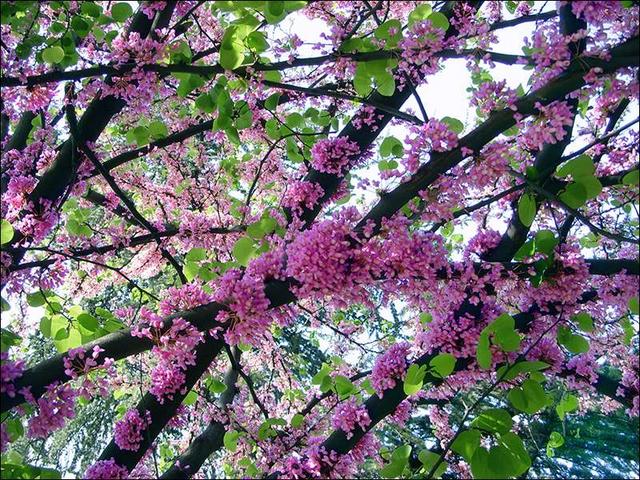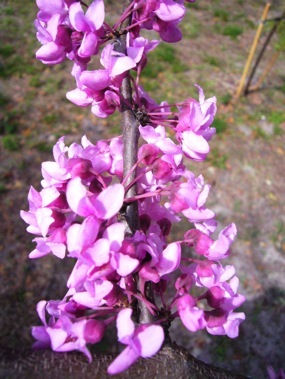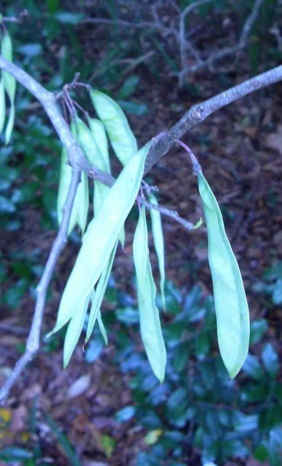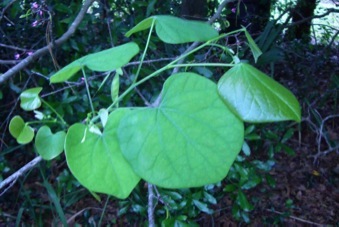
Eastern Red Buds can be showy in spring. Photo by Green Deane
Cercis canadensis: In The Bud of Time
It’s one of those trees that if you don’t see it at the right time you’re not looking for it the rest of the year. I had gone past it perhaps four or five dozen times over a couple of seasons, but never in spring. But one day the blossom caught my eye. I knew what it was I just hadn’t seen it there before.
Eastern Redbud trees are native across much of the United States and Canada, basically east of the Rockies. The most common species is Cercis canadensis (SER-sis kan-uh-DEN-sis.) They’re small trees in the pea family and among the first to bloom in the spring before they leaf out. They also produce large numbers of multi-seeded pods, from spring to late summer depending where it is.
Native Americans ate redbud flowers raw or cooked as well as the young pods and seeds raw or cooked. The flowers can be pickled. They have a slightly sour taste and are high in Vitamin C . They’re a pleasant addition to salads and can also be used as a condiment. The unopened buds can be pickled or used as a caper substitute. The seed is about 25% protein, 8% fat and 3% ash. More so, a 2006 study show the flowers and the seeds to be very high in antioxidants as well as linoleic and alpha-linolenic acid. The seeds also have oleic and palmitic acids. Think of it as The First Forager’s Health Food Store. Young leaves are edible raw or cooked.
Redbuds were first cultivated in 1641 and even George Washington planted some around Mt. Vernon. The name Cercis canadensis, as usual, has Greek and Latin origins. Cercis is from the Greek “kerkis” which means “a weaver’s shuttle” and refers to the shape of the pod; canadensis means “of Canada.”
The redbud’s native range is New Jersey to central Florida, west to Missouri and Texas and northern Mexico. It’s branches and stems also have been used for basketry.
Also edible are the flowers and pods of the C. occidentalis (found in western North America ) and the C. siliquastrum found in Europe. There are also several cultivars now of varying colors. One popular variety is called Forest Pansy. It has reddish leaves and pods. They are edible as well. Like all members of the pea clan the blossoms are a very distinctive “wings and keels” arrangement, keel in the middle, wings on either side.
Green Deane’s “Itemized” Plant Profile
IDENTIFICATION: Small deciduous tree, typically 20 feet in height, gracefully ascending branches, rounded shape. Alternate, simple, broadly heart-shaped and 3 to 5 inches high and wide. Leaves emerge reddish, turning green. Flowers are pea-like, wings and keel, rosy pink with a purplish tinge. Flowers develop before the leaves in spring, in clusters along the branches.
TIME OF YEAR: Flowers in spring, followed by pods, seeds in fall.
ENVIRONMENT: Full to partial sun, well drained soil, often planted as an ornamental. I have also seen them growing, poorly, in total shade. They also seem to grow along the edges of open spaces.
METHOD OF PREPARATION: Buds raw, pickled or cooked. Flowers raw or cooked, young pods fried. Flowers fry nicely as well. Young leaves edible, raw or cooked. Regarding the flowers, the light colored upper part of the blossom is sweet, the darker lower part is bitter. Some folks removed the lower bitter part before eating. It’s a personal choice.
HERB BLURB
Herbalists say extracts from the inner bark and roots were used to treat colds, flu and fever. The Alabama Indians man a root and inner bark infusion for fever and congestion. The Cherokee used a bar infusion for whooping cough. The Delaware used an infusion of the bark to treat fever and vomiting. The Osage used charcoal from the wood for war paint.
Redbud Blossom Muffins
2 cups redbuds blossoms
2 tablespoons minced fresh sage or rosemary leaves
½ cup sugar
Minced zest of 1 lemon
1 ½ cups flour
2 teaspoons baking powder
½ teaspoon baking soda
¼ teaspoon salt
1 large egg
3/4 cup milk
1/2 cup yogurt
2 tablespoons melted butter or oil
1 tablespoon lemon juice
Topping:
1 tablespoon sugar
½ teaspoon ground cinnamon
Preheat oven to 375°F
In bowl #1, combine redbuds, herb, sugar, zest. Let sit 30 minutes.
In bowl #2 Sift flour, powder, baking soda, salt large bowl.
In bowl #3 Combine egg, yogurt, milk, oil, lemon juice.
Pour the content of bowl one in to bowl two and toss.
Add the wet ingredients from bowl three, stirring to just moisten. Do not over mix.
Fill your muffin tins 3/4 full.
Combine sugar cinnamon the topping sprinkle some each muffin Bake for 25 minutes, or until tops spring back when lightly touched.
Remove form muffin pan and cool on a wire rack.





